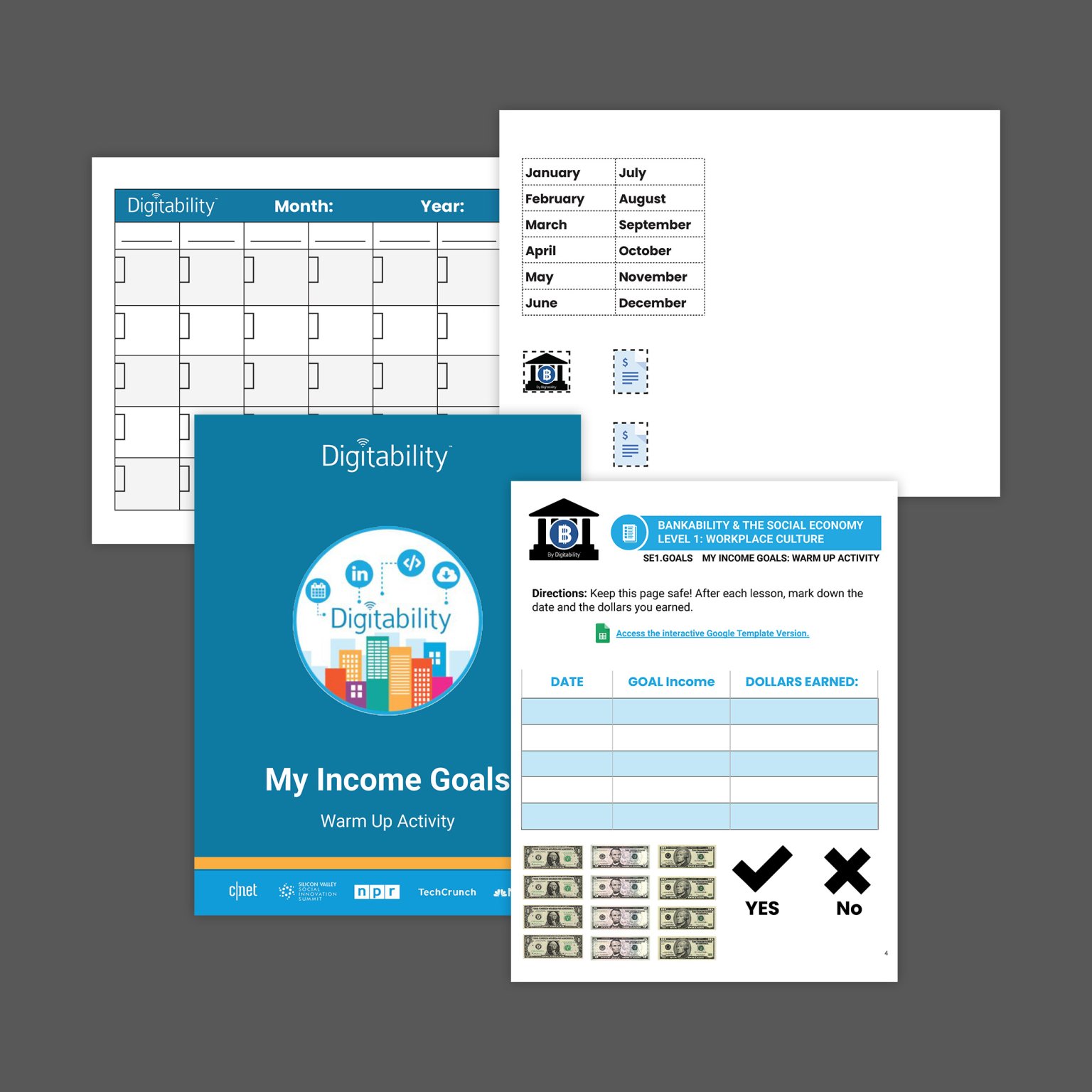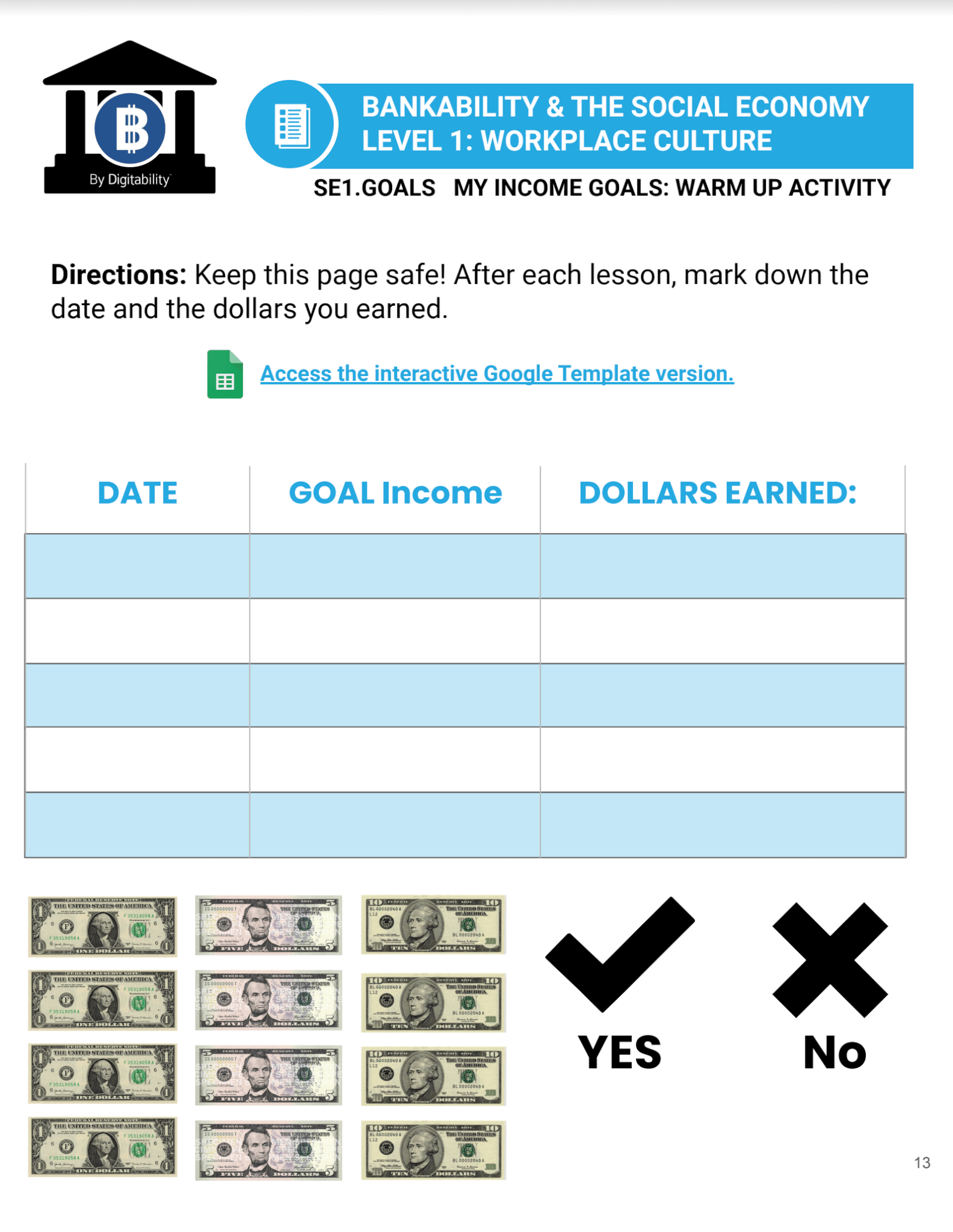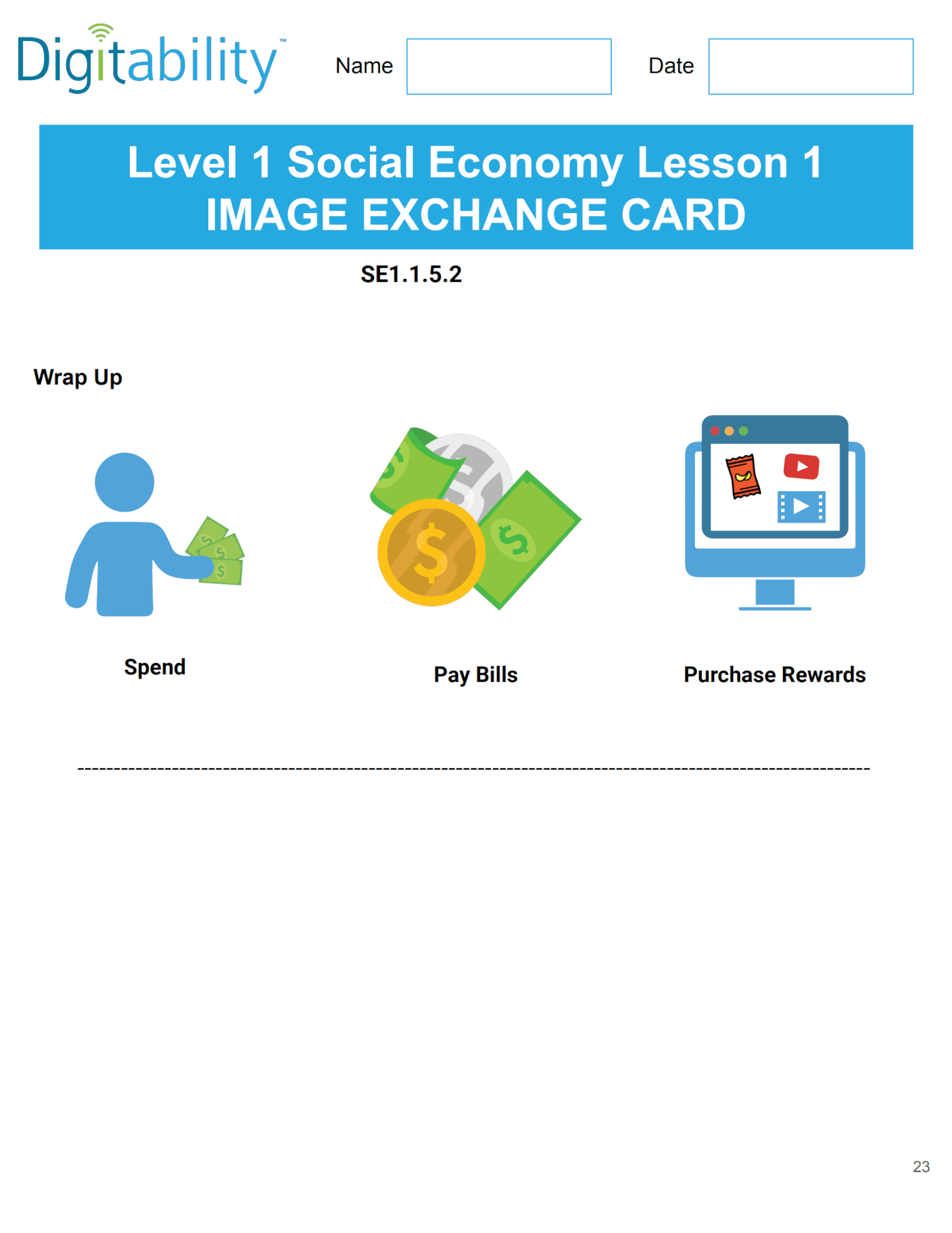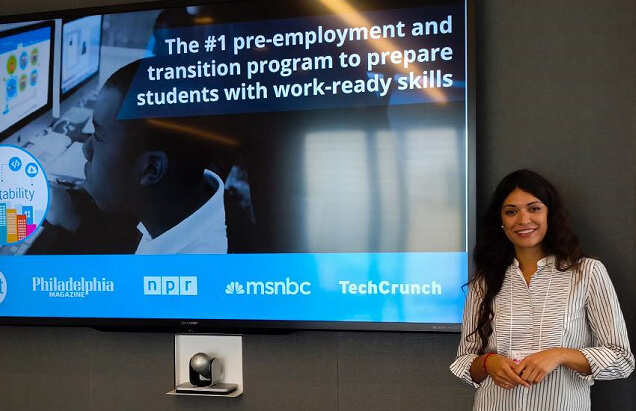Modifying Instruction During the Wrap Up

No Two Students are the Same; Neither are their IEP Goals
Each student requires something different when it comes to their list of IEP goals. Every day teachers are charged with finding ways to engage, support, motivate and differentiate for each of their students.
Digitability has organized strategies for streamline evidence-based practices for any given classroom with a wide-range of student needs including varying cognitive abilities, expressive and receptive language, self-regulation skills, and age-appropriate behavior. It’s a tall order for life skills teachers to manage.
Get Your FREE Quote Today!
Overview of the Wrap Up
For the lesson Wrap Up, the Chief Financial Officer will read off the total earnings for each student. Doing so, reinforces participation as an appropriate workplace behavior and financial literacy. The teacher will then prompt students to discuss what they will do with their earnings.
This may include paying bills, purchasing rewards, or saving for larger purchases. Students will then return to their “My Income Goals” worksheet and record their earnings for the day, which they can compare to the goal they set for themselves that day. Teachers can use this as an opportunity to expand learning for certain students by asking follow up questions. For example, “When is our next bill due?” Or, “How much money will you need to pay your bills?”
The Wrap Up also includes an Independent Practice activity. Students will practice self-regulation and adhering to workplace boundaries through the Independent Practice. Students will earn Following Directions Dollars for unlocking badges that have been assigned to them. However, learners who work ahead of the assigned badge and unlock badges that have not been assigned will pay a Not Following Directions fine of $1. In order for students to complete the Independent Practice, they will have to login on their technology. Some students may require more support to do this and to stay on task while doing so. For those students, a teacher or support staff can help the student login and actively monitor their work on the Independent Practice.
Meet the Student Personas
Note: The following personas are meant to illustrate a range of cognitive, communicative and behavioral needs for a wide-range of learning styles. These personas were created to help teachers identify the characteristics and associated strategies for their students needs.

Advanced Tier 1 Student: Drew can read, write, and comprehend paragraphs. Academically, he is one year below grade level. He is reinforced by getting time to use his phone during school. Drew has low motivation to complete assignments. He has difficulty with self-regulation and responsible decision making. He also has difficulty with impulse control. Drew is charismatic and his peers are drawn to him, giving him the potential to be a leader.

Tier 1 Student: Marcus can speak in 2-3 sentences and is able to read and comprehend paragraphs. He is reinforced by watching videos on Youtube. Marcus’ behaviors that impede learning include interrupting and complaining. He consistently is helpful with other students in the class and is a strong problem solver.

Tier 2 Student: Abbey can speak in 4-5 word utterances, and she is able to read with little comprehension. Abbey is reinforced by listening to music. She has some behaviors that interfere with learning, such as making off topic comments and teasing others. Abbey tends to perseverate on fairies and princesses, which contributes to her off topic comments. However, Abbey is an active participant in lessons and frequently shares with her peers.

Tier 3 Student: Jonathan is primarily nonverbal, he uses a communication device inconsistently, and knows some signs. He is not yet reading and has limited listening comprehension. Jonathan is reinforced by playing computer games. He demonstrates behaviors that interfere with learning, such as aggressive behavior and not following directions. However, Jonathan consistently greets others and likes to participate in lessons.
Strategies for an Advanced Tier 1 Student

Advanced Tier 1 Student:
Functional Academics: Can read, write, and comprehend paragraphs; Academically, he is one year below grade level.
Language: Age-appropriate
Reinforcers: Time to use his phone during school
Behavior: Low motivation to complete assignments. Difficulty with self-regulation and difficulty with impulse control.
Strengths: Charismatic and his peers are drawn to him, giving him the potential to be a leader.
During the Wrap Up: The teacher asks “For a Participation Dollar, what will you do with your earnings?” When asked about his goals for his money, Drew should be given the opportunity to respond verbally. Due to his low motivation, he may begin to whine and say “I don’t want to do this.”
Strategies for Addressing Attention Seeking Behavior
- Drew is avoiding an undesirable task by engaging in whining behavior. Because he is engaging in task avoidance, the teacher should ensure to follow through with the task demand. The teacher can use Positive Narration and draw attention to a student who is engaging in the expected behavior. “Jonathan answered that he was going to pay a bill with his earnings, Jonathan earned a Participation Dollar! Who else can answer our question to earn a Participation Dollar?"
- The teacher can address Drew more directly to engage him in the activity. "Drew, for a Participation Dollar that you can use toward cell phone time, what will you do with the money you’ve earned today?”
- The teacher can also use a supplemental resource and their physical presence to engage Drew in this activity, creating an opportunity to provide positive reinforcement with some support. Using a Digitability T3 Supplemental resource, the teacher can walk over to Drew's desk holding up the Image Exchange Cards that correspond to the Wrap UP. "Drew, for a Participation Dollar, what will you do with the money you’ve earned today?”
- When Drew responds to the Wrap Up questions without engaging in inappropriate behavior, the teacher should provide immediate feedback using the embedded Digitability language formulas.
repeat the answer + describe the behavior + deliver consequence
"Drew said he will buy time to use his cell phone, great job earning a Participation Dollar!"
In Level 2 of Digitability's Workplace Behavior Unit, students will identify and practice both the behaviors that will support their success in the workplace, as well as those behaviors that can be perceived as problematic. In these lesson plans, Digitability will explicitly explain how complaining impacts the workplace and depict strategies for developing self-regulation skills and a self-advocacy plan. In this level of Digitability, the teacher can utilize the Social Economy to assign a $1 fee for complaining to help Drew analyze the frequency of this behavior and strengthen his strategies for self-regulation. To learn more, contact our team.

- What is an Extinction Burst? It is important to understand that with some interventions the behaviors may seem to increase in frequency, intensity or duration before they begin to decrease. This is called an extinction burst. Evidence-based practices embedded in Digitability's Social Economy are tools that should be used consistently in order to be effective. It won't be a one-and-done solution!
Strategies for a Tier 1 Student

Tier 1 Student:
Functional Academics: Can read and comprehend paragraphs
Language: Can speak in 2-3 sentences
Reinforcers: Watching videos on Youtube
Behavior: Interrupting and Complaining
Strengths: Consistently helpful with other students, strong problem solver
During the Wrap Up: The teacher asks “For a Participation Dollar, what will you do with your earnings?” Marcus should be given the opportunity to verbally respond to the Wrap Up questions. However, as the teacher asks Marcus his plans, he may engage in echolalia, repeating the teacher’s question back instead of providing an answer.
Strategies for Extending Responses
- Echolalia typically occurs when a student is aware that they should be responding to a question, but they do not immediately have the words to respond. The teacher can prompt Marcus toward a correct response.

The teacher can first provide a sentence starter to help Marcus begin his response. “With my earnings, I plan to…” This verbal prompt will help Marcus form an answer to the question asked of him.
- If Marcus continues to engage in echolalia, the teacher can provide a visual prompt by showing Marcus the Image Exchange Cards that correspond to the question.
- When Marcus makes a selection, the teacher can model the full sentence for Marcus to repeat. “I will pay a bill.”
- When Marcus responds to the Wrap Up question, the teacher should provide immediate feedback using the embedded Digitability language formulas.
repeat the answer + describe the behavior + deliver consequence
"Marcus said he will pay a bill, great job earning a Participation Dollar!"
- In Level 2 of Digitability's Workplace Behavior Unit, students will identify and practice more behaviors in the workplace that will support their success in the workplace as well as those behaviors that can be perceived as problematic. In these lesson plans, Digitability will explicitly explain how complaining impacts the workplace and strategies for developing self-regulation skills and self-advocacy plans for the workplace. To learn more, contact our team.
Strategies for a Tier 2 Student

Tier 2 Student:
Functional Academics: Can read with little comprehension, some writing skills, low IQ
Language: Speaks in 4-5 word utterances
Reinforcers: Listening to music
Behavior: Making off-topic comments due to perseverating on fairies and princesses, teasing others
Strengths: Actively participates in lessons, frequently shares with peers
During the Wrap Up: The teacher asks “For a Participation Dollar, what will you do with your earnings?” Abbey may not initially respond, and will require additional prompting in order to provide an answer.
Strategies for Prompting a Tier 2 Student

A verbal prompt can be provided by giving Abbey a verbal sentence starter for her to expand on, “With my earnings from today, I will…”

A visual prompt can be given by showing Abbey the Image Exchange Cards that will help her choose a response.
- When she does select one, the teacher can verbally model answering the question in a complete sentence. “With my earnings, I will buy a reward.” Then, Abbey can repeat the sentence.
- When Abbey responds to the Wrap Up question, the teacher should provide immediate feedback using the embedded Digitability language formulas.
repeat the answer + describe the behavior + deliver consequence
"Abbey said she will purchase a reward, great job earning a Participation Dollar!"
- In Level 2 of Digitability's Workplace Behavior Unit, students will identify and practice more behaviors in the workplace that will support their success in the workplace as well as those behaviors that can be perceived as problematic. In these lesson plans, Digitability will explicitly explain how complaining impacts the workplace and strategies for developing self-regulation skills and self-advocacy plans for the workplace. To learn more, contact our team.
Strategies for a Tier 3 Student

Tier 3 Student:
Functional Academics: Not yet reading, limited listening comprehension, low IQ
Language: Primarily nonverbal, uses a communication device inconsistently, knows some signs
Reinforcers: Playing computer games
Behavior: Aggressive behavior, not following directions
Strengths: Consistently greets other, enjoys participating in lessons
During the Wrap Up: The teacher will ask “For a Participation Dollar, what will you do with your earnings?” To prompt Jonathan in answering, he can be given the Image Exchange Cards. However, Jonathan may not follow directions and may push the cards away from him instead of selecting an answer.
Strategies for Addressing Not Following Directions
- If Jonathan physically pushes away the Image Exchange Cards, the teacher should first give Jonathan a reminder of the expected behavior to earn reinforcement. “Jonathan, you can earn a Participation Dollar that you can use toward buying computer game time for answering the question. Let’s try again, for a Participation Dollar, what will you do with your earnings?” The teacher can present the Image Exchange Cards again.
- If needed, the teacher may present the Image Exchange Cards in a different manner. This could include either showing them on the screen and having Jonathan point or touch his answer, or holding them in the teachers’ hands so that he cannot push them away.
- Additionally, the teacher could make the array of Image Exchange Cards smaller by removing one card from the array. Giving Jonathan one less option to choose from will make the task less overwhelming and more manageable.
- When Jonathan provides a response, the teacher should provide immediate feedback using the embedded Digitability language formulas.
repeat the answer + describe the behavior + deliver consequence
"Jonathan will pay a bill, great job earning a Participation Dollar!"
- In Level 2 of Digitability's Workplace Behavior Unit, students will identify and practice more behaviors in the workplace that will support their success in the workplace as well as those behaviors that can be perceived as problematic. In these lesson plans, Digitability will explicitly explain how complaining impacts the workplace and strategies for developing self-regulation skills and self-advocacy plans for the workplace. To learn more, contact our team.
If you need additional resources or assistance in differentiation, reach out to your coach!






